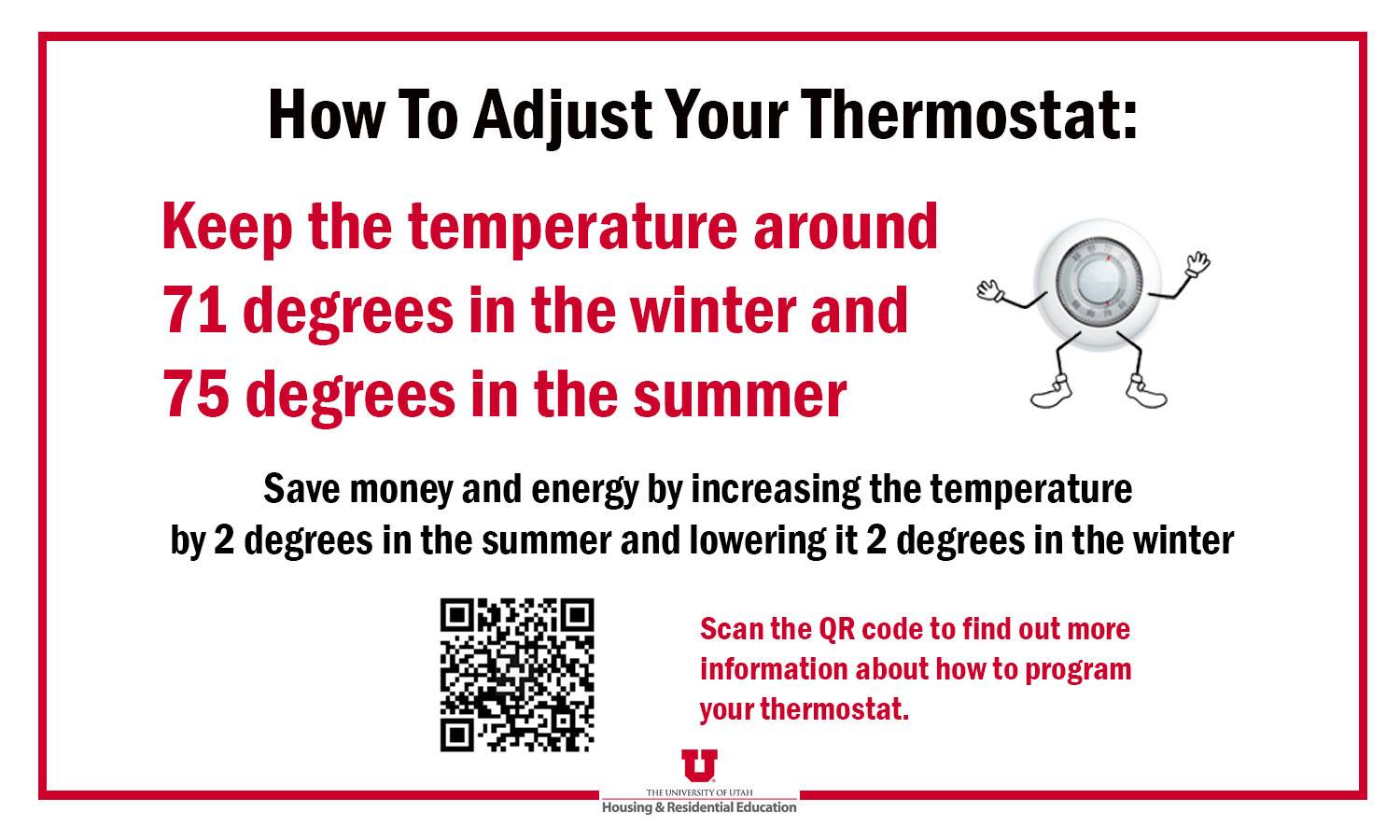THERMOSTATS 101
Why Should I Adjust my Thermostat?
Adjusting your thermostat closer to the outside temperature is an easy way to save money on energy bills and also help save the environment.
Studies show that:
-
If everyone in the U.S. changed their thermostat by 1°F, net savings across the U.S. would amount to 5.1 billion dollars.
-
If everyone in the U.S. changed their thermostat by 1°F, it would reduce annual carbon emissions by 7.2 teragrams.
-
7.2 teragrams is the equivalent of the amount of carbon released by 1.4 million people in a year.
-
A 1°F thermostat change nationally can also save 482,000 terajoules of energy per year.
Source: Energy, Carbon-Emission And Financial Savings From Thermostat Control, Oak Ridge National Laboratory, May 2013.
Types of Thermostats
Mechanical Thermostats

Mechanical Thermostats
These thermostats have a limited range of functions and perform best when set at a temperature around 72-73° F and left there at all times.
For more info, check out this article about mechanical thermostats.
Programmable Thermostats

Programmable Thermostats
Thermostats that allow for programming of temperatures for different times of days and for each day can be efficient at saving energy when a space is not occupied.
Check out this article to learn about how to program them correctly.
Smart Thermostats

Smart Thermostats
Smart thermostats are the latest innovation in controlling the conditions of a space, including more than just heating and cooling. Most can be controlled remotely from your smart phone.
Check out this article to learn more about the available options and what might be best for you.
FAQ'S
Look through the Frequently Asked Questions below and click on them to find answers, resources, and helpful information.
The Department of Energy suggests that your thermostat should be set somewhere between 68 degrees in the winter and 78 degrees in the summer. It is also recommended that you program them to change even more when you are sleeping and when you are away from home. The best temperature varies a little bit based on the type of thermostat, so check out the resources above listed under your type of thermostat.
One of the best ways to more effectively use your thermostat for energy and cost savings is to change it based on the occupancy of your home and the activity level of the occupants. For example, a great way to save energy and money is by reducing the heating or cooling:
- while you sleep
- while you are at work or school
- while on vacation or away from the house for an extended period of time
This can be done either manually or with a programmable thermostat. Smart thermostats even allow you to adjust them more often and remotely.
A smart thermostat allows you to control the thermostat and temperature settings of a space from a mobile device or laptop, even when you are not at home. It allows for more control over setting the temperature and adjusting them as needed. Smart thermostats have become increasingly popular due to their user-friendly design, convenience and cost benefits. For more information about switching to a smart thermostat, check out this resource: wattsmarthomes.com
There are many different ways to save additional energy in your home that work well with adjusting your thermostat or investing in a programmable or smart thermostat. These include:
- Replace incandescent light bulbs with halogen, compact fluorescent lights (CFLs), or LED bulbs which use anywhere from 25-80% less electricity and last a lot longer.
- Use smart power strips to reduce energy waste of electronics, such as TVs, game consoles, and stereos, when they are not in use.
- Consider switching to more energy efficient windows reduce heat and cool loss.
- Insulate your home, including spaces such as attics, walls, basement, and crawl spaces.
Click here for more energy saving home improvement ideas.
We can't always afford to make home improvements or upgrade to a smart thermostat. While we save up for these, there are simple, behavioral things we can do to still make an impact. These include:
- Open your windows when it is nice outside. In the warmer months, open them in the morning or evening to let in cooler air and shut them as it gets warmer during the day.
- Reconsider your clothing choices. Wear more layers or longer sleeves in the winter so you can stay comfortable without needing to heat your whole home more.
- Use your ceiling fans and other fans. Be sure it is spinning correctly to push air down into the room to create air flow and cool you off.
- Add/Remove more blankets or sheets to/from your bed. This will allow you to be comfortable while you sleep without needing to adjust the thermostat.
Institutions such as the University of Utah, other colleges, and work places manage many public shared spaces. Actions we do in our homes to be more energy efficient can, to some extent, be done in these public places as well. Try doing the following:
- If possible, program the thermostat for your office, classroom, or shared space just as you would your home.
- If programming the thermostat is not an option, be sure it is turned off when a space is not occupied. Most public spaces such as shared offices and classrooms have two simple settings of occupied and unoccupied. When occupied, the space will be heated or cooled to a comfortable temperature.
- Turn off lights when a space is not in use. This may sound cliché, but it does have an impact on energy savings.
- Switch out your space heater for an electric blanket. Space heaters use more energy and make it difficult for heating and cooling systems to properly regulate a space's temperature. Electric blankets use much less energy and provide the warmth directly to you instead of to the space.
- Show your support for more investment in renewable energy, such as the U's recent investment in more geothermal energy.
Getting involved in the community is a vital part in helping us all become more energy efficient and fight the effects of a changing climate. There are many ways to get involved including:
- Join and/or support an advocacy group, such as Utah Clean Energy, to learn how to get involved and connect with other supporters.
- Show your support for a legislative bill in your city, county, or state that works to further clean energy. HCR 11 in the state of Utah is one such bill that supports the Utah Roadmap for Positive Solutions on Climate and Air Quality.
- Reach out to your representative and express your desire for additional clean energy bills and more reform in the government in support of climate solutions.
- Lead by example. Take part in the initiatives and make behavioral changes so that others will do the same.
Additional Information
ThermoSavings
This page was made as part of the ThermoSavings campaign from the Anthropocene Now Praxis Lab.

The objective of this campaign is to help the University of Utah reach and accelerate its carbon neutrality goals and educate the campus community about how they can get involved.
Thermostat Stickers
 Download the sticker file here
Download the sticker file here

Survey Results
As part of the the ThermoSavings campaign, campus community members were surveyed about their understanding and opinions of thermostats and their use. Some of the results are found here.
92% of respondents gave a 4 or 5 on the scale (1-5) to the prompt “It is important to use your thermostat effectively.” However, only 49% gave a 4 or 5 out of 5 to “I know how to use most of my thermostat's functions.”
87% of respondents gave a 4 or 5 out of 5 to indicate their knowledge of how to change the thermostat temperature, but 62% indicated “no knowledge” of rules concerning thermostats on campus.

The chart above shows that nearly everyone (98%) is compelled by either environmental or monetary benefits to adjust thermostats by 2 degrees. The chart below shows almost the same amount of people support the U being a leader in sustainable development and becoming carbon neutral as soon as possible.





